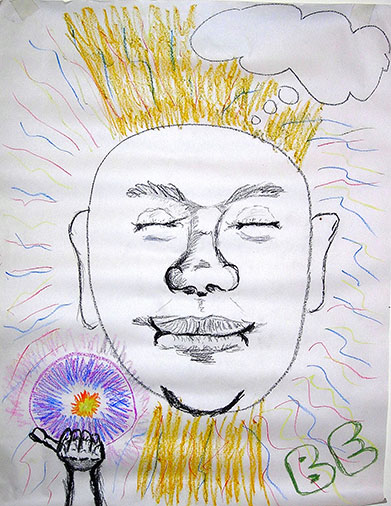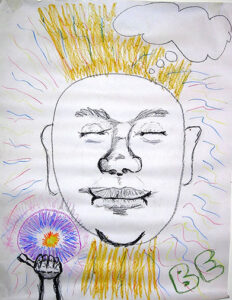A Story of Addiction and Recovery

Ripening Seeds Article / March 2008
Published in the International Expressive Arts Therapy Association Newsletter
To Begin Again: A Story of Addiction, Recovery and Renewal
Adriana Marchione, MA, REAT, RSMT
I forget my song
My life an upside down dream
Lost, I chase whispers*

‘Be‘, Drawn at an expressive arts recovery retreat
Where to begin my story, this story that now has many arms and legs. This story that has torn my heart open and put it back together and often has ripped my heart open again. I want to share with you the deep seeds, the ones that were planted forcefully without my knowing, and the seeds that I dropped in the ground with strong conviction. I am an artist first and foremost, and for more than ten years have been working in the field of expressive arts therapy. I was born in Washington DC and have lived in the United States most of my life. This article tells the story of my opening into the arts as a lifestyle and eventually specializing in working with issues of addiction and recovery through my expressive arts practice.
The essence of this truth begins with addiction, my own alcoholism. This alcoholism consumed me for over seven years but began with a core anxiety, one that didn’t allow my mind to rest or my body to learn that it was real and trustworthy. I began drinking at seventeen and found that drinking was a solace, a friend that could accompany me anywhere and everywhere. Drinking gave me freedom from fear or inhibition, and while imbibing I enjoyed a playful and often dangerous edge to my lifestyle.
Along with the burgeoning of my drinking career was the beginning of the roots of my art life. I went to college and majored in studio art with a specialty in photography/mixed media. My creative world offered me imagination and focus while my drinking was fuel for excitement and oblivion. I found myself flying, entering into a world with no limits and (consequently) shaky ground. It was a carnival of sorts, a topsy-turvy orientation; I had my camera eye on most of the time, taking pictures at every turn, feeling exposed without my lens in front of me. Having a ‘buzz’ afforded me the numbness I needed to move around despite my anxiety, periodic depression, and an existential loneliness that would show up in inconvenient and unexpected ways.
To fast forward through a long story, life became unmanageable as the years moved on, that predictable outcome familiar to many addicts. The danger became scary, the edges became hardened, and the excitement escalated to spinning out of control, hurting me, hurting people around me, taking away my inspiration and ultimately, my hope. I grew up in Ohio and most of my early drinking took place there. But when I hit ‘my bottom’ (what recovery circles call the darkest place of the addiction – the place that will bring you to your knees where if you are lucky you finally surrender the fight) I had landed in San Francisco, a city where dreams can be found and lost, where transformation can grab you in an instance and flip your reality upside down. I flipped within a year of arriving in San Francisco, despite my hopes that the city would raise me up as an artist of greatness –instead I found myself in the Mission District hanging out with drug addicts and alcoholics. These young poets, artists and Generation X’s weren’t able to offer me anything except one more drink to soothe my disorientation and my discomfort, which was beginning to be a constant state of being. My pain demanded that I stop pretending that turning away from reality, truth and depth of spirit was sustainable and I was graced with sobriety.
Within four years time, after working with a therapist, attending Alcoholics Anonymous meetings, finding work that gave me more stability than living hand to mouth, and developing a community that supported my new sober lifestyle – I began to study expressive arts therapy through training at the Tamalpa Institute. While drinking my art was a passion that brought the outside in through photography and found images, it helped me organize my world. But when I got sober, my art became a way to express my inner world, to make sense of who I was. This was a slow road, one that at first didn’t feel substantial enough or translatable to anyone but me. Yet when I began opening up to the expressive arts practice of creating, I was relieved. I could feel myself from head to toe, my cells were alive; slowly my stories, the complications of my emotional life, the fear and struggle had a voice.
While at Tamalpa I realized my own journey with addiction was my jewel, and this new knowledge of my self could be translated to others with similar issues. Right away I began to share the work; I had groups beginning as I was completing my training. My first workshop focused on the theme of ‘Mask/Unmask’ where I used the concept of ‘mask’ to represent the addicted life and ‘unmask’ to symbolize the undoing of addiction (what lies under this layer of defense). This laid the groundwork for many more workshops and group offering. Since this initial inspiration to work with the recovering population using my own recovery as my resource, the train has never stopped.
Since then, this specialty in addiction/recovery has informed my work in the world. I have developed a specific body of work for recovering addicts that offer creative healing opportunities that complement other addiction support systems (such as treatment programs, 12-step groups, psychotherapy, etc.). Through my work with individual clients and groups, at residential expressive arts retreats and various treatment facilities in the San Francisco Bay Area, I have witnessed the efficacy of the expressive arts tools to enhance and deepen the recovery process. The clients and students I have worked with range from folks who have suffered from drug
addiction/alcoholism, eating disorders, sex and love addiction and co-dependent systems. I have found that expressive arts therapy can very concretely support recovery in the following ways:
1) provides the opportunity for people in recovery to experience themselves more fully through the many levels of awareness (i.e. mentally, emotionally, and physically)
2) creates a strong container that can hold difficult feelings, thoughts and memories though body awareness and arts processes
3) nourishes the organism through movement and the arts, being present through the creative process
4) can become enlivened (thriving not just surviving), which can manifest in joyful, playful, and transcendent feelings and experiences without the altered experience of addictive behavior
5) connect to a deeper sense of spirituality that is experienced and felt through creative processes
6) improves the quality of life in recovery, providing the opportunity for play and sensory awareness (pleasure, sensuality) to be incorporated more fully into recovery
7) promotes self-esteem by redefining oneself in recovery – arts can help to form a new perception of self through symbols, images, postures and narratives
I’d like to share the story of one such recovering addict, a man in his 50’s recovering from drugs and alcohol. He came to me broken in many ways physically and emotionally. He was a kind soul who was curious about tapping into his creativity through the arts. He began attending my yearly expressive arts recovery retreat in the Santa Cruz Mountains of California and then eventually started doing individual and group work with me. One of his defining characteristics was a distinct stutter, which inhibited his communication significantly and in turn contributed to a lack of self-confidence. We worked slowly to honor his pace through the years he engaged in the expressive arts. Over time his poetry and his writing, as well as his detailed drawings, became stronger and more defined. Every year he would join the recovery retreat with an open mind and find a safe haven through the arts processes while being witnessed by the other group members. Although stiff and uncomfortable in his skin from the years of abuse, his integrity would emerge through images, and by his wise words that he would share haltingly. Addiction is life depleting and he along with countless other addicts have suffered from this soul loss. In contrast, the arts are life giving and offer another chance to not only sustain the soul over time but to touch the very beauty that is at the heartbeat of existence.
One of the most significant discoveries for me while not only engaging in my own expressive arts processes but also bringing them to others, is how the arts offer a unique opportunity for recovering persons to channel their intensity of spirit into form. One of the characteristics of ‘addicted’ personalities is a deep passion and drive for heightened experience. This drive usually gets funneled ineffectively into the addictive behavior as a way to reach for the ‘divine’, the spark of life. Through using drugs or alcohol, altering oneself through sex or love addiction, over-eating or depriving oneself of food as a way to manage feelings, and/or escaping one’s own self through co-dependency in service of others – all are repressed forms of tapping the well of life and inspiration. Art-making gives us another alternative, a way to place that depth of being (our myths, images, emotional truth) into a constructive form. Unlike addiction, this act of creating gives back by providing sustenance, self-esteem and often a true sense of belonging. At this juncture, I am at a time in my life where I have seen the seeds grow and blossom several times around my work, and feel extremely blessed for all the recovering persons that have put their trust in me and the expressive arts work to color their world.

‘Self Portrait‘, Created by a heroin addict in early recovery
As I complete my offering, I would like to acknowledge my late husband Eddie Oberste. He was also a recovering addict and alcoholic and had seventeen years of sobriety when he passed away on June 25, 2007 after a two year battle with lung cancer. A large part of my growth as a recovering person and an expressive arts therapist I can attribute to my partnership with Eddie. Eddie came into my life at 25 and became my lover, my dear friend, my colleague and eventually my husband. Eddie grew alongside me over the years in his work, eventually changing his career to involve addiction/recovery counseling, alcohol research and finally a successful business in family interventions. Eddie always helped me to move forward and to embrace the depth of my knowing in helping others in this work, as well as challenging me to learn even more about love and integrity.
sun on land rests peace
surrounded by a soft yes
life continues here**
Adriana Marchione, MA, REAT, RSMT, maintains an expressive arts practice in San Francisco. She can be reached at [email protected] or at 415-206-9630.
* This haiku poem is my aesthetic response to the ‘concept’ of addiction
** This haiku poem is my aesthetic response to the ‘concept’ of recovery. This is an exercise that I have recently been sharing with students that I train.